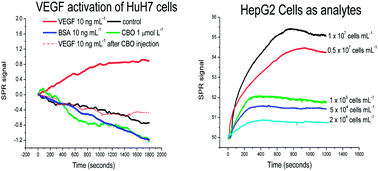On-line surface plasmon resonance biosensing of vascular endothelial growth factor signaling in intact-human hepatoma cell lines
Abstract
Surface plasmon resonance (SPR) monitoring of biorecognition events at intracellular levels is a valuable tool for studying the angiogenic response of carcinoma living cells during tumor growth and proliferation. We report here a comparative study of two different strategies to detect human hepatoma cell interactions between transmembrane vascular endothelial growth factor receptor (VEGFR2) and vascular endothelial growth factor (VEGF). To monitor VEGFR2 activation after VEGF stimulation, intact hepatocellular carcinoma HepG2 or Huh7 cells (2 × 105 cells per mL) were directly immobilized on the sensor chip. Distinguishable SPR sensorgrams were obtained for each cell line depending on the time required for VEGFR2 activation. SPR signals for VEGF–VEGFR2 binding were inhibited by the VEGFR inhibitor, CBO-P11. The SPR response after VEGF stimulation/inhibition was in good agreement with the results observed by immunoblotting analysis. In a second approach we used intact cell lines as analytes. SPR analysis was done by injecting HepG2 and HuH7 cell suspensions (2–4 × 104 cells per mL) onto a sensor surface previously immobilized with VEGF via a thiol self-assembled monolayer (SAM). Specificity and reproducibility were evaluated reusing the same chip surface over more than 60 complete regeneration cycles. Comparison between both methods yielded differences in terms of reliability, making the latter strategy more effective for the analysis of real samples. The investigation of VEGF signaling in intact human hepatoma living cells by SPR monitoring comprises a novel and promising design for the study of tumor angiogenesis via downregulation of VEGF and VEGFR2 pathways. Further investigation on VEGFR activation and vascular function could contribute to establish a robust and meaningful tool for early cancer diagnostics.


 Please wait while we load your content...
Please wait while we load your content...